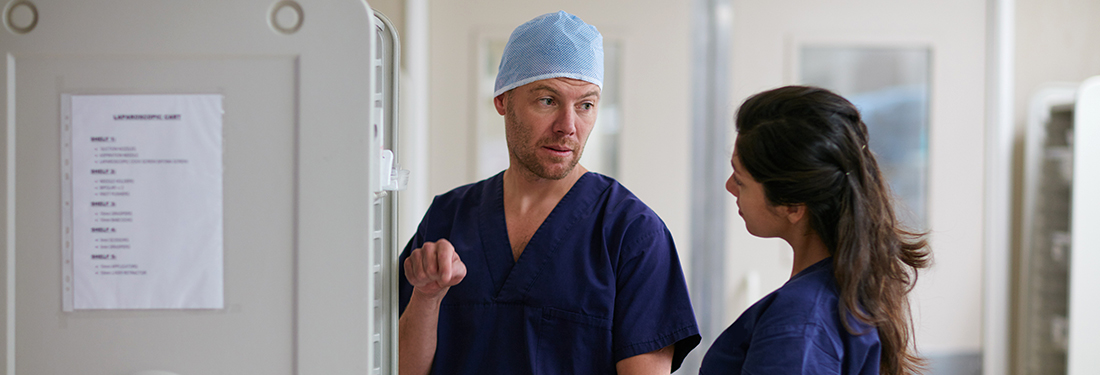Measuring Success When the Lean Improvement Work Is Complicated
When I talk with health care leaders about lean improvement work, I’m often asked, “How much should I expect to receive as a return?” At Virginia Mason, we don’t focus on financial returns after every event. Instead, we focus on identifying and eliminating waste for the sake of our patients and our staff — which in turn results in long-term financial benefits. In health care, we pay our employees for their time, but how much of this time is unproductive as they work in wasteful processes? In other words, how much of their time is spent looking for tools to do their job and asking others for clarification about their tasks because the processes aren’t clear?
If we can find ways to eliminate wasteful activities — so that supplies are where employees need them, every time, and so that their processes make sense at the start — then the return on our improvement work is huge. As we eliminate waste, we gain a more efficient workplace, with better patient care, better access and employees who have more capacity to do the work that is meaningful for patients and themselves.
“We focus on identifying and eliminating waste for the sake of our patients and our staff — which in turn results in long-term financial benefits. In health care, we pay our employees for their time, but how much of this time is unproductive as they work in wasteful processes?”
How we work together to battle difficult problems in health care
In our lean work, sometimes we think that finding the waste and eliminating it will be fairly straightforward — and sometimes it is. At other times, as we dig deeper with the questions, we discover unexpected complexity. For example, when nurses wanted to be closer to their patients’ bedsides, we discovered a range of barriers — from missing supplies, to the supplies in the wrong locations, to different approaches to patient care processes, to supply chain inconsistencies, to shift coverage that extended to different, disconnected locations on the nursing units and more. How do we keep from getting discouraged? How do we continue to push forward?
We don’t panic.
We use our lean tools, such as value stream maps and PQ analysis, to understand our demand and how our staff work affects patient care. Through years of experience, we know that when our teams work together respectfully, they succeed with improvements to patient care, staff engagement, efficiency and costs.
We remember why this work matters.
We know that the work we do will make a difference to patient safety and patient satisfaction, and we know it’s the right thing to do. We also know that the work will ultimately make the jobs better for our staff. If we discover partway through the process of trying staff-initiated improvement ideas that our ideas aren’t working, we know we’re learning and we keep going in search of the next solution.
We take the time to document the burden of work on our staff.
When we observe the work being done on the front lines and use a standard work sheet (also known as a spaghetti map) to illustrate the current state, we’re showing respect for the staff doing the work. Instead of telling staff to do one more thing, we let them know we’re here to help relieve the burden of wasteful work and possibly remove one thing. They know we’re there to help.
We develop realistic targets, and we realize them through incremental improvements.
When we took on the goal of getting nurses closer to their patients, we developed time targets, defect targets and quantity targets. We measured the number of call lights that went on in a 10-minute period. We measured nurses’ footsteps away from the bedside. Idea by idea, event by event, we used our targets to track our progress. And everyone knew the prize: giving nurses more time with our patients. We knew this was the “secret sauce” to improving quality and reducing cost.
We create more initiatives, if necessary, to reach our goals.
When we saw the number of barriers keeping nurses from the bedside, we created two teams to act on two different initiatives to help our patients and our nurses. One team worked on improving the ability to assign nurses to patients through adjacent, geographical assignments, and the other team worked on bringing supplies to the point of use so that the right supplies were just where nurses needed them, at exactly the time they needed them. Together they made the perfect equation — reducing the burden of work in order to return time for care.
We encourage and expect our staff to generate insanely great ideas.
The best ideas come from the people who do the work, and we see this happen in every event. The ideas are practical, they’re easy to implement and they work. When we were trying to figure how to move our supplies closer to the patients and to the nurses, one nurse asked, “Why should I have to leave the patient’s room to get my supplies?” Later, a nursing assistant asked, “How can I know when the supplies are low without disturbing the patient or the nurse?” These questions spawned the ideas that became a reality: supplies were stocked in clear containers that were not only at the point of use for nurses inside patient rooms but also visible to the assistant nurses in the hallway who were in charge of stocking the supplies from outside the room. These developments are simple and they are revolutionary!
We work in teams to test our ideas, implement them and create standard work to sustain the improvement.
The team working on geographical assignments found ways to reset nurses’ shifts so they always started closest to their patients before they were asked to cover other shifts, and they tested the placement of nursing stations by trialing work stations on wheels. These new stations became the much more effective teaming sections in our new facilities, which are adjacent to five patient rooms to provide needed care yet just far enough away for staff teaming while letting patients rest.
How adding value to work produces better financial outcomes
At the end of the day, when we’ve met our targets to spend time with patients, increase access to care and make the jobs of our talented staff so much better, we know that our lean work is connected to our financial outcomes. Call lights disappeared; nurses’ footsteps decreased dramatically. The potential to prevent unsafe situations was heightened because the patient was finally within eyesight most of the time.
When we see our staff working in wasteful processes, we know that the time wasted on activities that aren’t valuable is time they can’t spend to meet their patients’ expectations. As leaders, we don’t have to say, “Let’s take 20% off the top.” We can work with our teams to increase value in their workday. If we pay staff for their time, why not find ways to engage them to eliminate waste and increase the value of the work they want to do for patients?
Related Services
Executive Retreat
Our executive learning experience explores lean methods, the connection between systemwide respect and safety, and the essential leadership qualities necessary for transformation: transparency, visibility and a sense of urgency.
Custom Seminar
Our customized learning experience not only details Virginia Mason’s history of successfully applying its patient-centered lean tools and methods to health care, but also addresses the participating organization’s specific challenges and opportunities.
Creating a Culture of Safety
Learn to analyze an organization’s safety culture and develop a sustainable action plan to intensify your patient safety initiatives. Attend this hand-on workshop to discover practical applications that will resonate with — and energize — your leadership team.
Aligning Physician and Executive Stakeholders
This interactive experience invites participants to assess their current state of physician and executive engagement, learn new tools, create a detailed road map to engage stakeholders and develop new strategies to navigate adaptive change.






